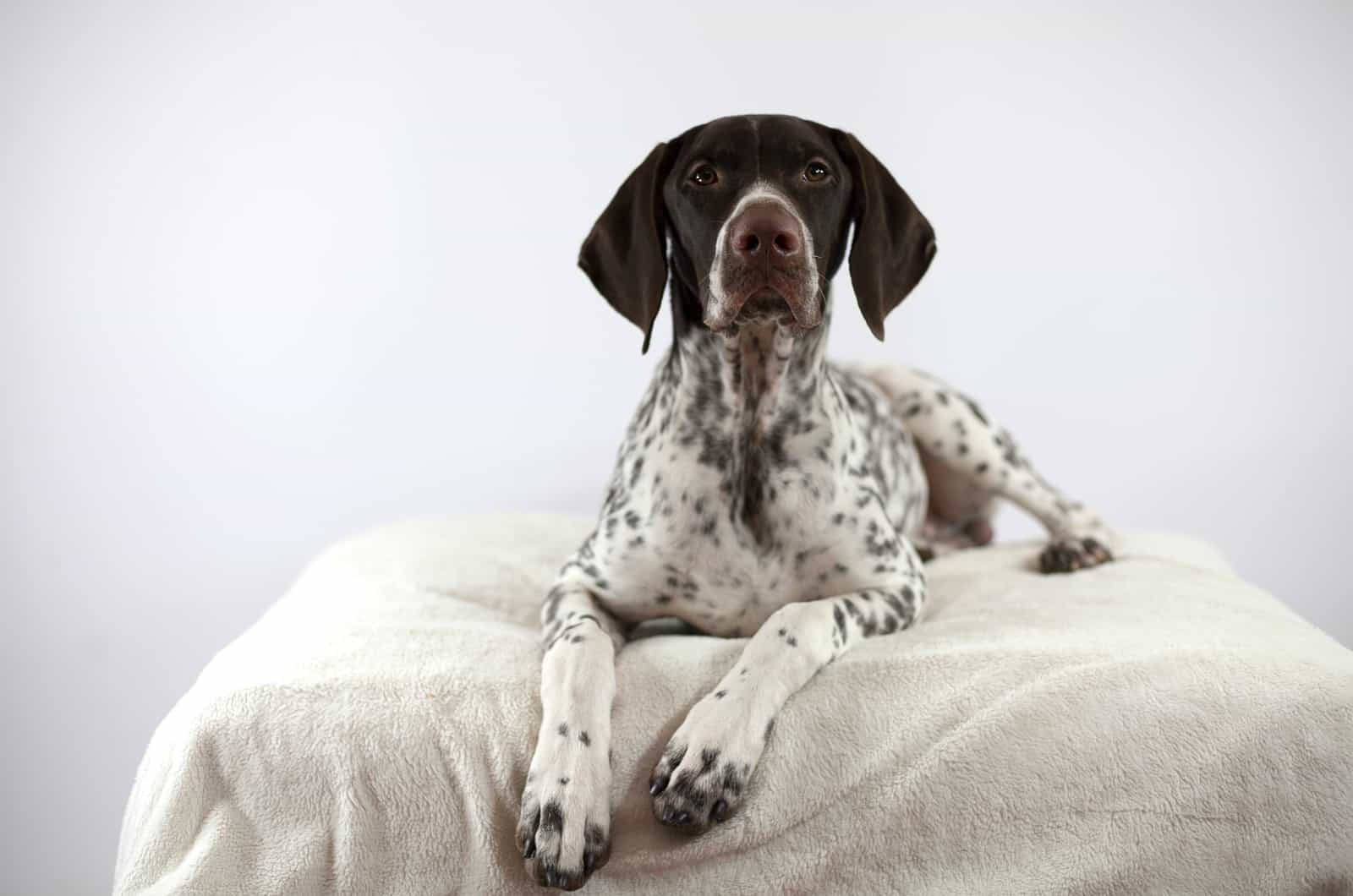German Shorthaired Pointers, also known as GSPs or Kurzhaars, are considered the perfect pointer dog by many breed lovers. They are active hunting dogs that are still bred to be working dogs, even though they are becoming more popular as family dogs – especially considering the large number of German Shorthaired Pointer colors available.
This dog breed originated from Germany. In fact, they were bred according to the German bird dog tradition that was established back in the 1700s. They were used by German hunters as duck retrievers and gun dogs and were considered one of the best bird hunting dog breeds.
With their high activity level and sleek bodies, they are also considered among the best water retrievers and make amazing swimmers. If you’re perhaps wondering what type of dog name would suit these restless pups, try giving them one of the hunting dog names you can find here.
While some canine lovers confuse them with English Pointers, these two have many differences – and one of the most noticeable ones is in the coat length, as well as in standard German Shorthaired Pointer colors.
German Shorthaired Pointer Color Chart
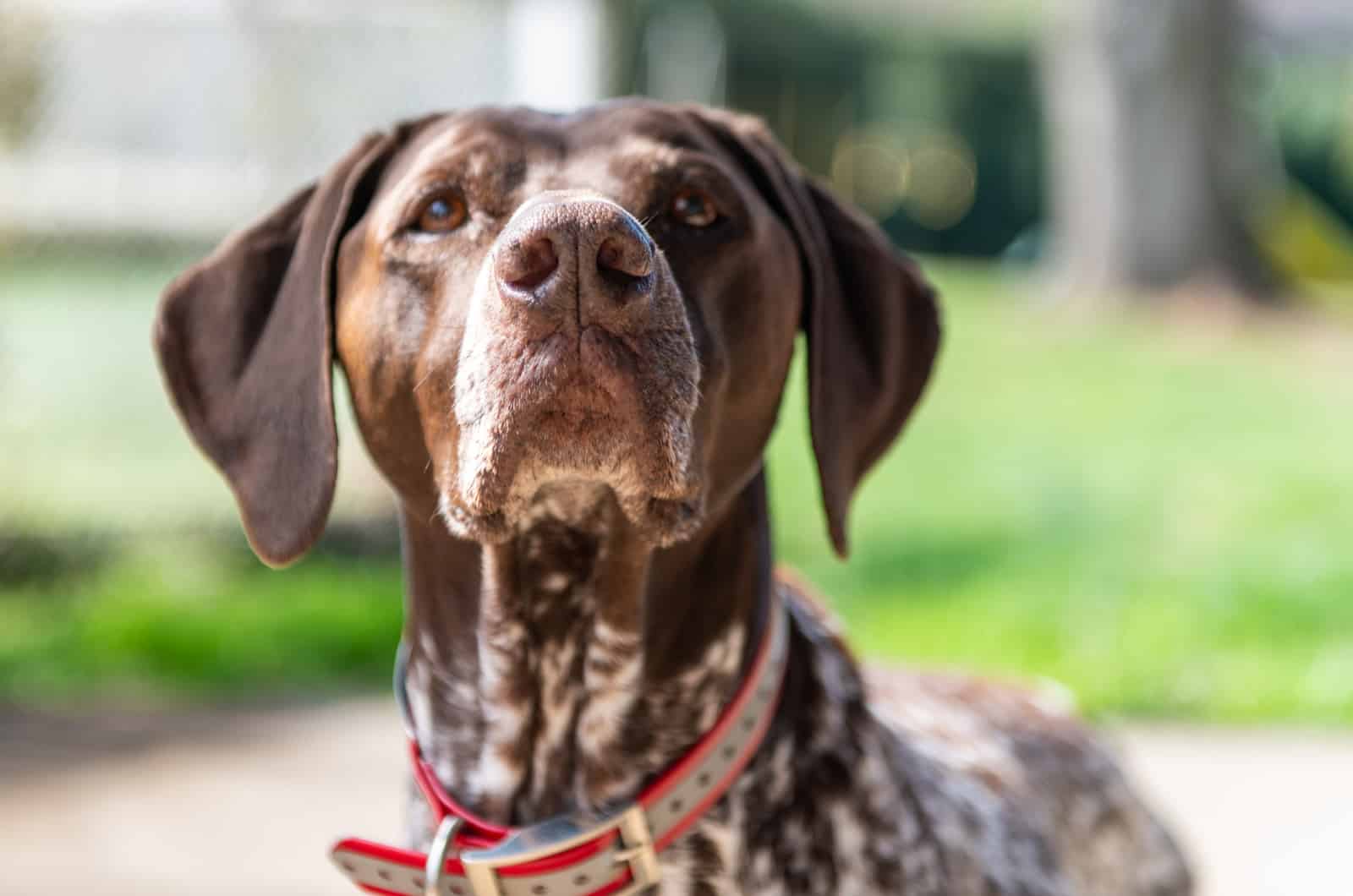
Before we get further into the topic, here is a German Shorthaired Pointer color chart that can give you a quick look into the German Shorthaired Pointer colors, according to the AKC:
[table id=250 /]
Without further ado, we’ll get into German Shorthaired Pointer colors.
German Shorthaired Pointer Coat Colors
According to the American Kennel Club (AKC), GSPs come in combinations of three colors:
• Black
• White
• Liver
As for standard patterns, you can find German Shorthaired Pointers in solid colors, patched, ticked, and roan.
While these are standard shades, you can find some German Shorthaired Pointer coat colors that aren’t considered standard, but their appearance doesn’t mean the dog isn’t purebred.
These are:
• Red
• Orange
• Lemon
• Tan
If you find a dog in some of the recognized but not accepted coat colors, this doesn’t mean your dog is mixed. However, you won’t be able to register your dog with kennel clubs, and he won’t be able to participate in conformation dog shows.
While these colors on their own sound pretty simple, not everyone knows what some of the more unique coat colors are – such as liver roan. To help you find out what each German Shorthaired Pointer color is, we have created a guide explaining all possible shades and patterns.
Genetics Behind The Colors
Just like every other physical trait of German Shorthaired Pointers, coat color is determined by genetics. It wasn’t until DNA tests became a regular thing that experts began to clearly understand what causes certain colors and patterns. We’ll try to simplify it for you.
All dog cells contain 39 pairs of chromosomes, and each of these chromosomes is made out of genes. Each gene is made out of a pair of alleles – one allele is inherited from each parent. Alleles are located at specific sites on a chromosome, called loci.
When two dogs mate, both mother and father will contribute by passing on one allele from each locus. Alleles can be dominant or recessive, with the dominant gene expressing itself and the recessive gene staying hidden but passed onto future offspring.
Every German Shorthaired Pointer color consists of only two pigments: eumelanin and pheomelanin. All possible coat colors you can see result from a combination of (or lack of) these two pigments.
Both pigments have one basic color. For eumelanin, this is black, and for pheomelanin, this is red. Lack of pigments causes the color white.
Various genes modify the exact shade of these two colors. For example, a blue/grey coat is caused by a dilution gene that modifies the black, keeping it light. On the other hand, pheomelanin can vary anywhere from cream, gold, and yellow to tan or dark red.
Genes control the intensity of each color, which is why you can find so many shades. In fact, some genes even control the pattern in which the colors are distributed. This is why you have so many coat patterns, such as pied, ticked, patched, or even brindle.
While dogs contain thousands of genes, only 8 of these are responsible for the coat appearance. These are:
• A (agouti) locus: This gene helps switch between different types of pigment. As such, it is responsible for most coat patterns.
• E (extension) locus: This locus is responsible for yellow and red coats, as well as red and yellow coats.
• K (dominant black) locus: This locus was only recently discovered. It is responsible for dominant German Shorthaired Pointer colors such as black, but also fawn and brindle.
• B (brown) locus: There are two brown alleles, dominant B and recessive b. Depending on the combination of these, a dog might end up entirely brown or with only brown patches.
• D (dilute) locus: This locus is responsible for dilute pigment. This is how you get certain coat colors such as gray or pale brown.
• M (merle) locus: The merle locus causes the distinguishable merle pattern that many dog owners • seek, despite it bringing with it many health problems for the dogs that have it.
• H (harlequin) locus: This locus is usually the reason behind colored spots on white base coats. It often interacts with the M locus to create unique patterns.
• S (spotting) locus: The S locus is the reason behind unique patterns such as parti, piebald, and asymmetrical white spots.
Now that you’ve understood what causes the German Shorthaired Pointer colors, it’s time to have an overview of each color individually.
Black German Shorthaired Pointer Colors
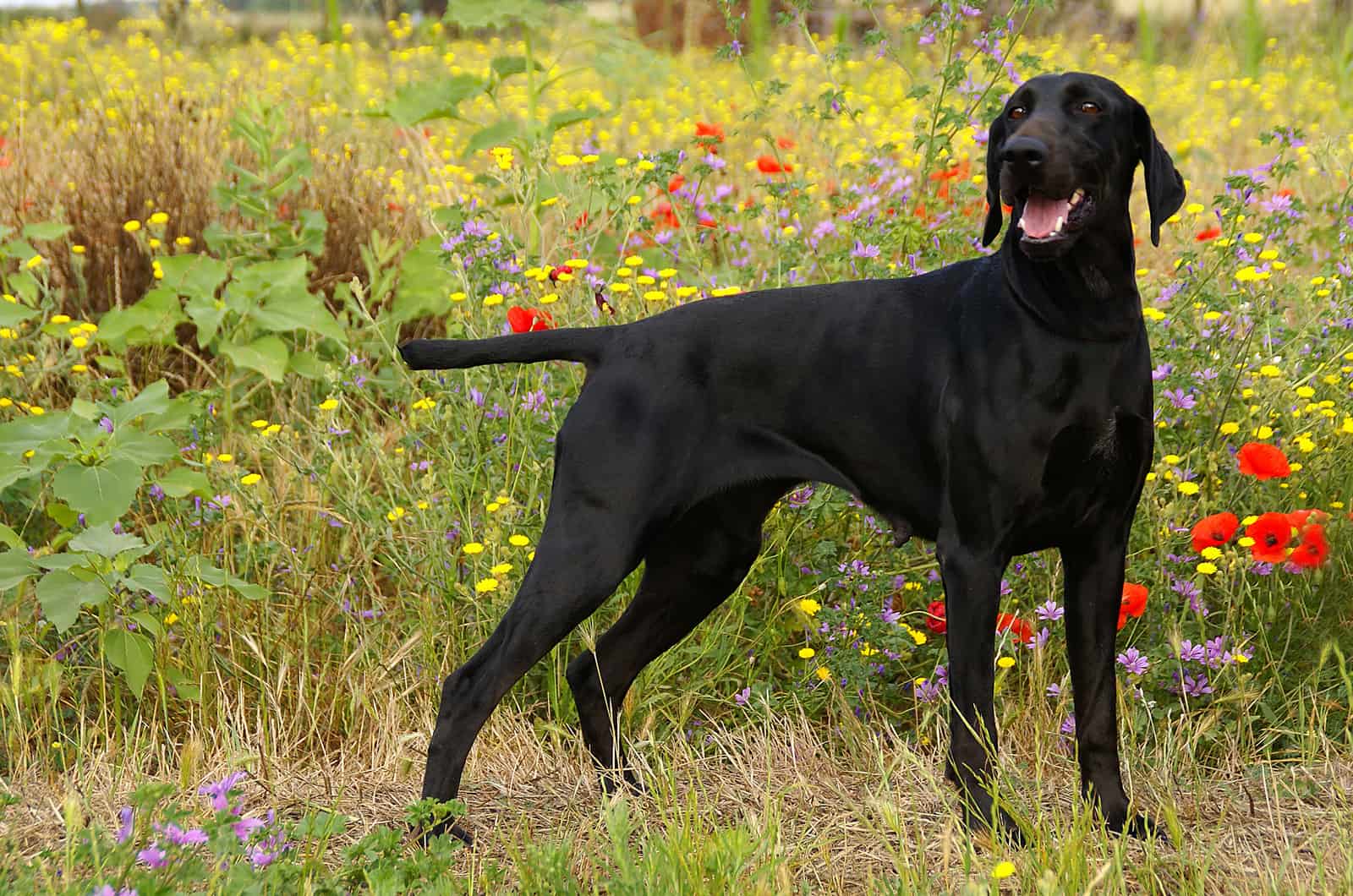
From a genetic standpoint, black is a rather simple coat color that is caused by the dominant gene. However, solid black German Shorthaired Pointers are rare – although they exist and are recognized by the AKC.
Overall, when it comes to black German Shorthaired Pointer colors, you can find:
• Solid black
• Black and white
• Black roan
Black and white German Shorthaired Pointers are patched dogs. Most of the time, they’ll have white legs, stomach, the tip of the tail, although sometimes only their head will be black. The important part is that the biggest portion of their body has to be black.
Most of the time, black and white German Shorthaired Pointers will have ticking on the white parts. This can make it challenging to differentiate standard black and white patches from black roan.
Roan German Shorthaired Pointers have an even mixture of white and pigmented hairs (in this case, black) that don’t become gray as the animal ages. This pattern, also known as the stitch pattern, is found in many horses, cattle, but also in some dog breeds, including German Shorthaired Pointers.
In some other dog breeds, the term might be mottled or belton, sometimes even ticked – although ticked in the case of German Shorthaired Pointers means spots of color.
For example, Spanish Pointers will be ticked, English Setters will be belted, while German Wirehaired Pointers will be roan.
Black roan is usually recognized by a white base coat with an almost dirty appearance, as there will be an equal amount of black and white hairs. As German Shorthaired Pointers have a short coat, this pattern is rather noticeable and gives the dog a unique appearance.
While some experts believe that roan is caused by the same gene that causes ticking, others disagree and think that an entirely different set of genes causes this pattern.
German Shorthaired Pointer Colors Liver
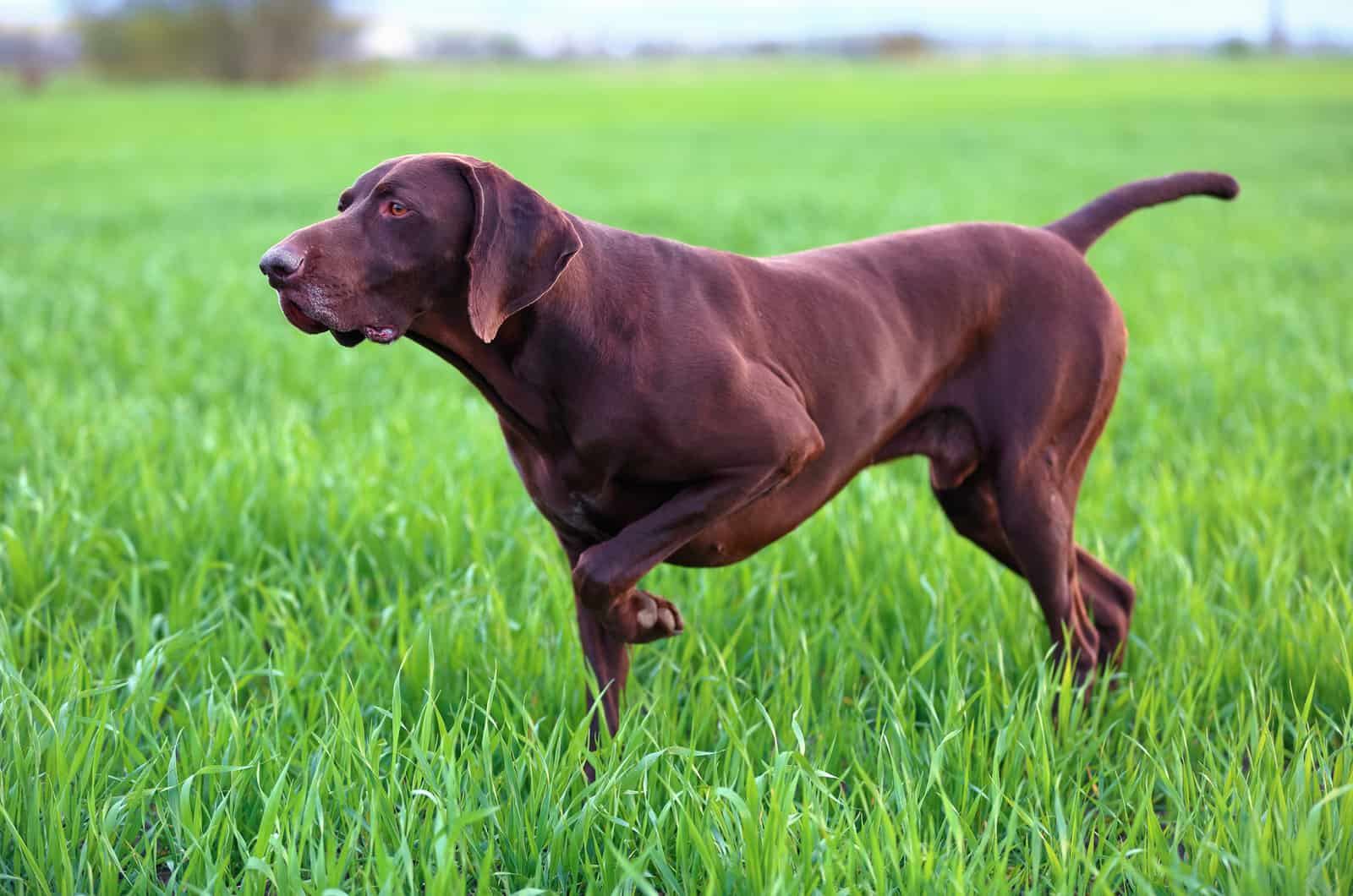
The liver coat color is somewhat unique in that it is a dilution of the black pigment in the B locus. Only a dog with two recessive bb genes will be liver.
What’s unique is that the liver gene dilutes all the black color in dogs, not just their coat color. In other words, you may find liver German Shorthaired Pointers in any coat color. However, one thing that differentiates them from red German Shorthaired Pointers or GSPs in some other color is the color of their nose.
Also, liver German Shorthaired Pointers don’t have to have liver parents. In fact, their parents usually have a Bb allele combination or something similar.
This means that they’ll appear black or in some other coat color but will be carriers of the recessive b allele. If both parents are carriers, the GSP puppy has a 75% chance of being black and 25% iver.
This table can show you how inheritance works. Keep in mind that only dogs with a bb gene are liver German Shorthaired Pointers:
[table id=251 /]
Nose color, as well as the color of the paw pads, lips, and eye rims, will always be brown in liver dogs. If the dog has a brown coat color and a black nose, he isn’t liver as the dilution gene isn’t present.
When it comes to German Shorthaired Pointer colors, there isn’t much confusion. These dogs can come in these patterns only:
• Solid liver
• Liver and white
• White and liver
• Liver roan
Unlike with black German Shorthaired Pointer colors, liver GSPs can come with a white base. The majority of their body can be white, as long as there are liver patches present.
Also, black and liver can never appear together on the same dog. Especially not in German Shorthaired Pointers who cannot have a standard red coat.
When it comes to liver and white German Shorthaired Pointers, the pattern distribution can be the same as in black and white dogs, with one difference: You can have more white than liver in these dogs.
Liver roan German Shorthaired Pointers have liver patches, as well as liver hairs on white markings. This makes them stand out from spotted or ticked GSPs, who may even have white spots on a liver coat.
Also, liver German Shorthaired Pointers have a higher chance of having amber or green eyes compared to the black or brown eyes these pups usually have.
White German Shorthaired Pointer Colors
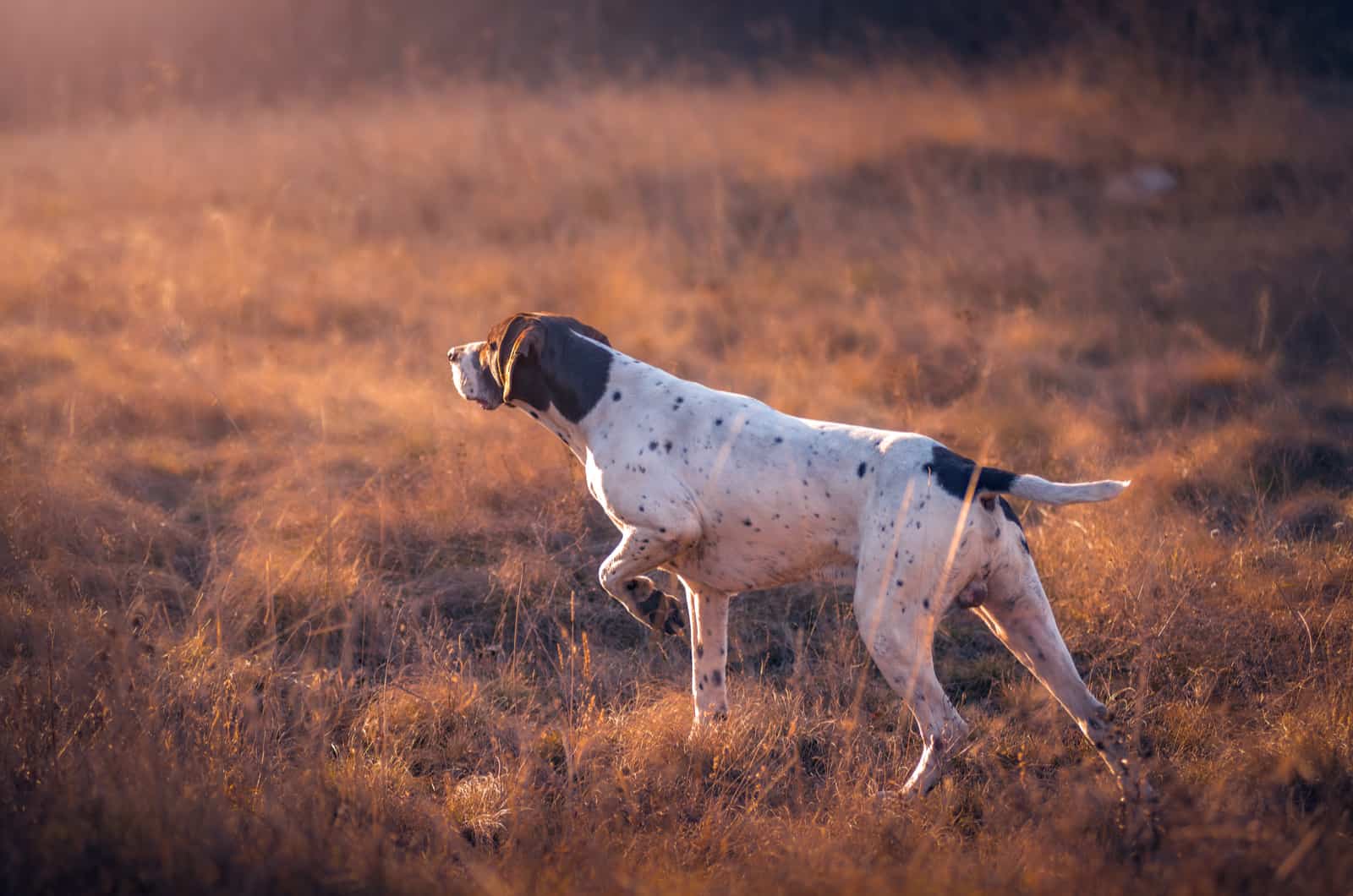
White is the only accepted German Shorthaired Pointer color that has to have some color in it to be recognized. Solid white German Shorthaired Pointers are either mixed breed, albino, or double merle, and neither of them is accepted by the AKC.
As such, you can find German Shorthaired Pointers in:
• Black and white
• Liver and white
• White and liver
While roan dogs have to have white markings, they are not considered white German Shorthaired Pointers. In fact, this is what makes the roan pattern in dogs differ from the one that appears on horses or cattle.
In most animal breeds where the roan pattern exists, it is found as white hairs on the colored part of the coat. Only in dogs, such as German Shorthaired Pointers, the roan is found on white.
As such, it is rare to find German Shorthaired Pointers with pure white markings, as most will have some type of ticking or spotting on them.
Gray German Shorthaired Pointer Colors
Gray, sometimes also referred to as blue, isn’t a standard German Shorthaired Pointer color. In fact, it is very rare, if not even impossible, to find in purebred dogs of this breed.
Gray is the result of another dilution gene, but instead of brown, it dilutes black in a bluish-silver shade. They are similar to liver German Shorthaired Pointers in the sense that they cannot have black patches on them, and their nose, eye rims, and lips have to be blue/gray.
Do German Shorthaired Pointer Colors Change over Time?
When a German Shorthaired Pointer puppy is born, he will usually be rather dark. However, pied markings or rather white patches will be visible right away. They won’t be born in a solid color, just for the patches to develop later on.
In fact, most of the time, the patches will remain the same throughout your dog’s lifespan.
One thing that will change, though, is the number of spots. German Shorthaired Pointers are usually born with solid white markings, but they’ll develop spotting over time. In fact, the first spots usually appear when they reach 5 weeks of age, not before.
The amount of spotting can increase over time. In fact, a dog who appeared to be pied might end up roan when he grows old! This is how big these changes can be.
Can German Shorthaired Pointer Color Influence Health?
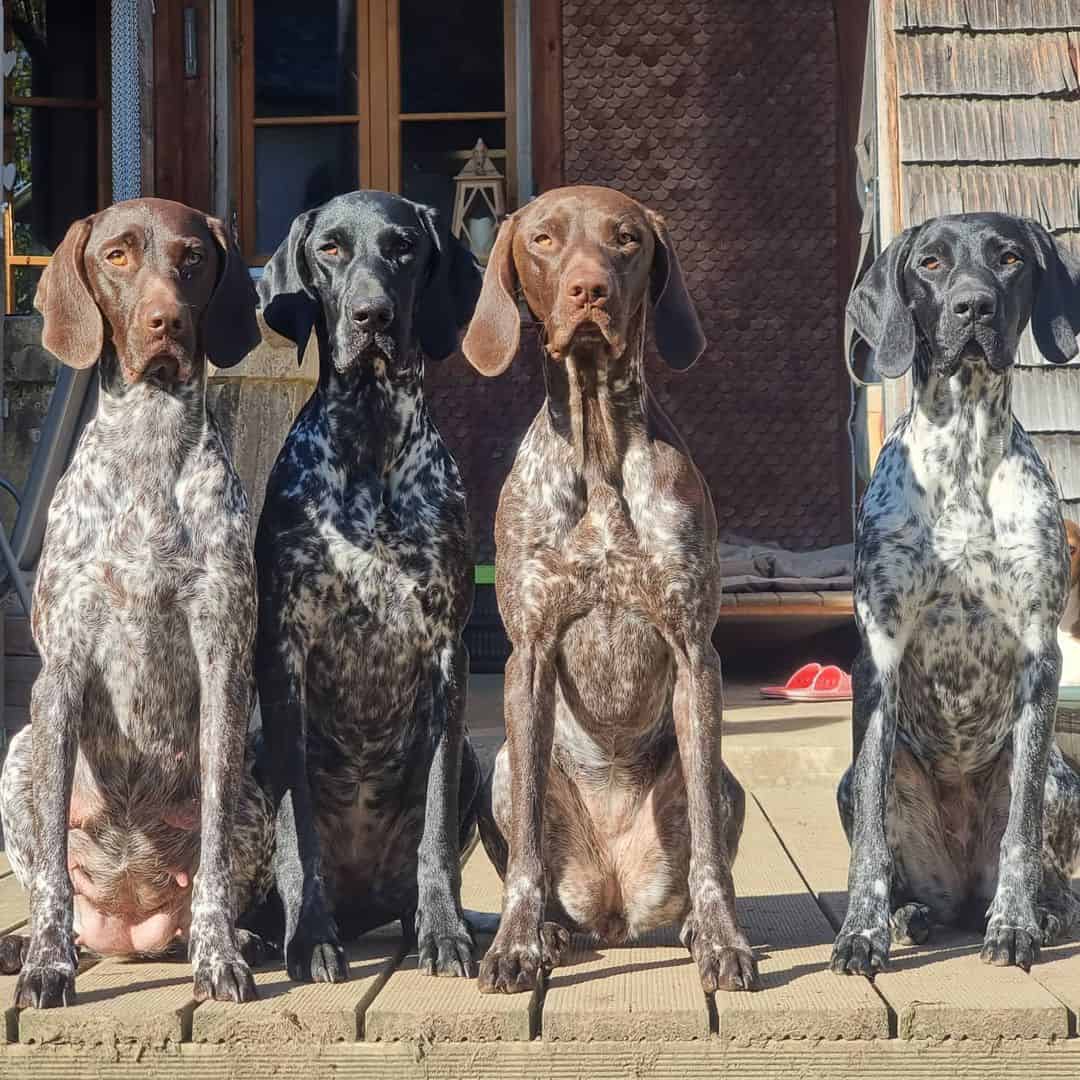
Photo from: @dkvomwaldlicht
Overall, coat color doesn’t affect a dog’s health. In fact, if you want to make sure you have a healthy dog, the best thing you can do is to look for responsible breeders. No matter the color of the dog’s coat, they’ll make sure to conduct necessary genetic testings on their dogs so they can rule out the further spread of harmful health conditions.
However, there is a reason breed standard exists and why some colors are considered desirable – and no, this isn’t only due to appearance.
The presence of some colors can indicate the existence of certain health problems.
For example, a solid white color can be caused by many genetic defects in dog breeds that don’t naturally come with white coats. The most common culprit is the merle gene.
While one merle gene causes the distinguishable merle pattern, two will make your dog appear entirely white. However, merle doesn’t just dilute the coat color. It dilutes all pigments in the dog’s body, as well as some other tissues.
This is why double merle dogs are more likely to be deaf, blind, or have severe bone and heart problems. No responsible breeder will ever intentionally breed merle dogs – although merle can sometimes stay cryptic, so you won’t know your dog has it until they pass it on.
Albinism is another condition that can cause a white coat, and it will also lead to problems with the heart and bones.
Some researchers also suggest that the chocolate coat color, as well as the parti pattern, might lead to an increased risk of several health conditions. However, there still isn’t enough evidence to prove this.
Also, if a certain coat color isn’t recognized, this means that the dog in question has a higher chance of being mixed. This isn’t important for many people, but it does matter if you want to participate in conformation shows or even in many dog sports.
Not to mention that you cannot be certain about the dog’s health if you don’t even know what his breed is!
How Long Do German Shorthaired Pointers Live?
While we’re talking about German Shorthaired Pointer colors and how they influence a dog’s health, it’s important to talk about the lifespan of GSPs and what you can expect.
Fortunately, GSPs are healthy dogs with an average lifespan of 12–14 years. For a medium-sized breed, this is rather long, so you can rest happy knowing your pooch will stay with you for a long time.
However, this doesn’t mean they aren’t prone to some health conditions. These include:
• Hip dysplasia
• Von Willebrand’s disease
• Entropion and ectropion
• Progressive retinal atrophy (PRA)
• Cardiomyopathy
• Hypothyroidism
• Gastric torsion (bloat)
How To Groom German Shorthaired Pointers
We’ve talked about German Shorthaired Pointer colors, but one of the things that worries aspiring dog owners the most is whether these dogs are challenging to groom and take care of.
As these pups have a short coat, they are fairly easy to groom. However, they do shed, so it is still important to take proper care of their fur. The best option would be to brush them several times a week. This will help collect all loose hair that would otherwise end up on your floor.
Fortunately, you won’t need a lot of different brushes for this job. A rubber curry comb brush might be a great option, as it won’t scratch their sensitive skin. They might even feel pleasant to the dog, who will love his grooming sessions!
You can choose whether you want to brush him in short sections or the entire coat at once. Use small, circular motions as they feel the best, and they’ll make sure you’ve removed most of the dead hairs.
If you are prone to dog allergies, a good idea might be to get a shedding blade. They are excellent de-shedding tools for short-haired dogs. Just remember that you have to be gentle. These brushes have sharp pins that can hurt your dog, especially when going around sensitive areas like the ribs or hips.
Still, for some dogs that have a rather thick coat or during the shedding season, using such heavy-duty tools is a great idea, and it can help you a lot.
Brushing is also a good moment to check your dog for any injuries, lumps, or bumps. This can give you an overview of his full condition.
German Shorthaired Pointers are prone to dry skin. Because of this, you shouldn’t bathe them too often, as baths can worsen this. Still, as they are dogs with high energy levels, this can be a challenge. They love getting themselves dirty, and there is nothing you can do to stop them!
If you happen to have to bathe your GSP more often than you’d like, it is a good idea to get some hydrating sprays. They can be of huge help with flaking and dandruff as they’ll moisturize your dog’s skin.
When bathing, keep in mind that you should never use human shampoo; stick to canine products. Also, you should prevent water and soap from getting into their eyes, mouth, and ears. To do so, you might want to cover their head with a towel or use cotton balls for their ears.
German Shorthaired Pointers are dogs that should always be bathed twice. This is because they can get rather dirty, and their coats are very thick.
You might want to blow-dry your GSP, as this will further help reduce shedding. However, as they have a short coat, this step isn’t necessary, and you can simply wipe them with a towel and let them air dry.
Don’t forget about ear plucking and taking care of his nails and paws! Also, brush your pooch’s teeth every few days to avoid plaque build-up.
If you want a professional to take care of your German Shorthaired Pointer’s coat, you won’t have to spend a lot of money. Visiting a groomer once or twice a year is more than enough for these dogs.
How To Reduce Shedding
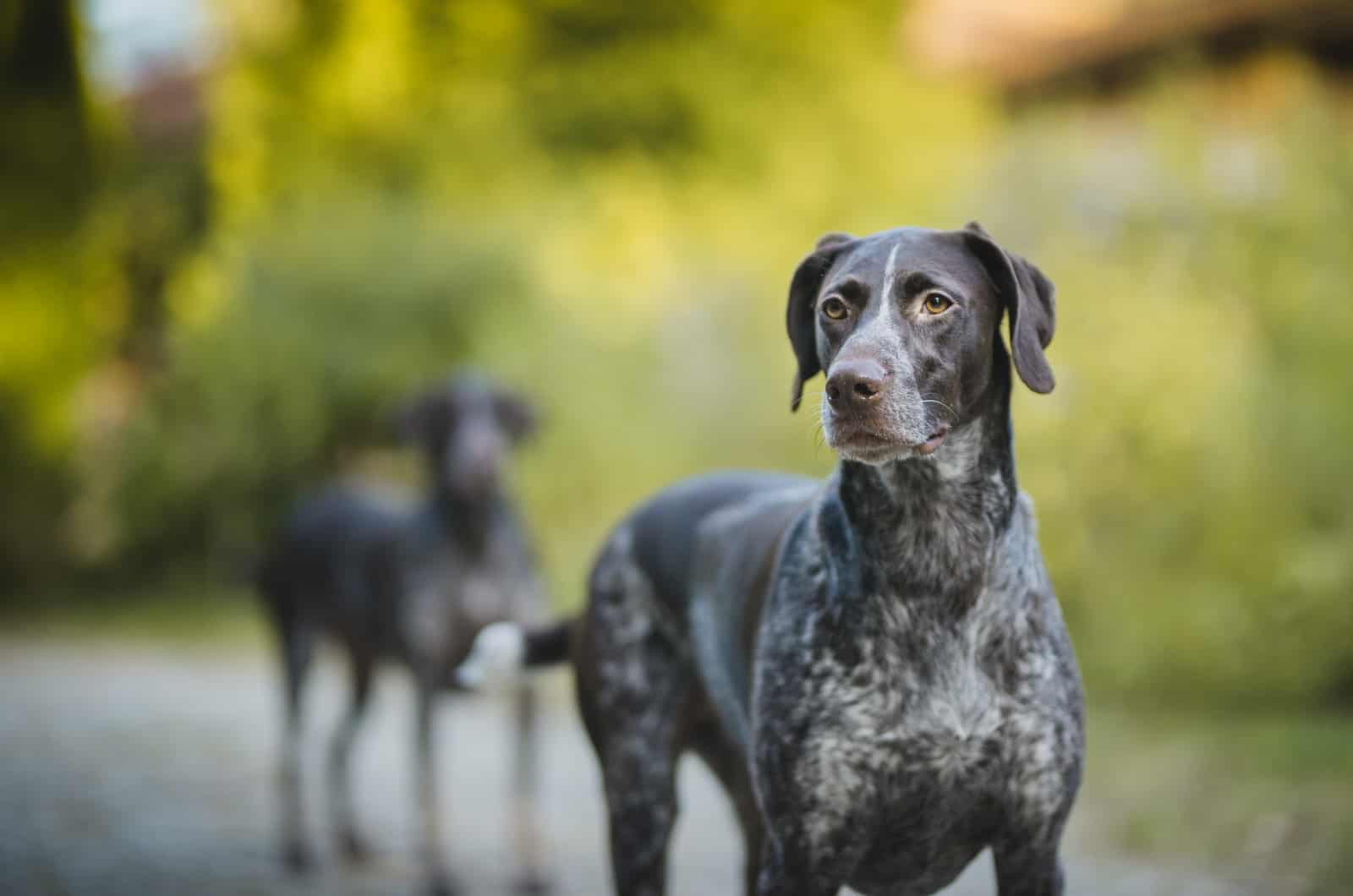
Other than frequent brushing and bathing, there are some other ways you can reduce shedding in your dogs. Be mindful of the fact that all dogs (except the few hairless breeds) shed. However, as long as this isn’t excessive, you can probably deal with it.
The most important thing when it comes to shedding is your dog’s overall health. To keep him healthy, you should feed him with high-quality dog food rich in omega 3 and omega 6 fatty acids.
These nutrients can help your dog’s coat and skin stay in good health. This will also prevent additional shedding while making your dog look adorable. You can find more details on the desirable food for this dog in our German Shorthaired Pointer feeding chart.
Keeping them well-trained is also essential. Their temperament and high prey drive are why dog training and socialization are so important. While not even a fully trained dog can be prevented from getting messy, it can help you make bathing and grooming sessions much more comfortable.
This can help you keep his coat maintained. The less he wants to get away whenever you come near the bathroom, the more you’ll be eager to groom him.
Never attempt to shave your dog to make grooming easier. Dog hair has a purpose, and shaving your dog will do more harm than good.
If you shave your GSP, he’s likely to get sunburnt. Also, his sensitive skin will be exposed, which can cause irritations. He’ll be sensitive to weather changes, especially when it’s cold. In fact, there is no guarantee that his coat will grow back in time for winter, and there might even be some bald patches later on!
Are German Shorthaired Pointers Hypoallergenic?
Hypoallergenic is a word you’ve likely seen plastered on food, beauty products, and fabrics. However, many people also call certain dog breeds hypoallergenic. To know whether GSPs are hypoallergenic, first, we must understand what this term means.
Hypoallergenic means that no allergens are present. Many people think that they’re having problems with dog hair. However, it is, in fact, the dog’s dander that’s giving you allergies.
All dogs produce dander or dry skin flakes. These flakes will stick to hair, then end up being spread around when the dog sheds. This is why you might have an allergic reaction when you come in contact with dog hair.
Other allergens are also found in the dog’s saliva and urine.
As such, no dog can be entirely hypoallergenic. Still, some dog breeds don’t shed and drool as much, making them suitable for people with allergies. However, you might still react to them.
When it comes to German Shorthaired Pointers, they are moderate shedders, so they are not a great choice for people who suffer from dog allergies.
Does German Shorthaired Pointer Color Matter?
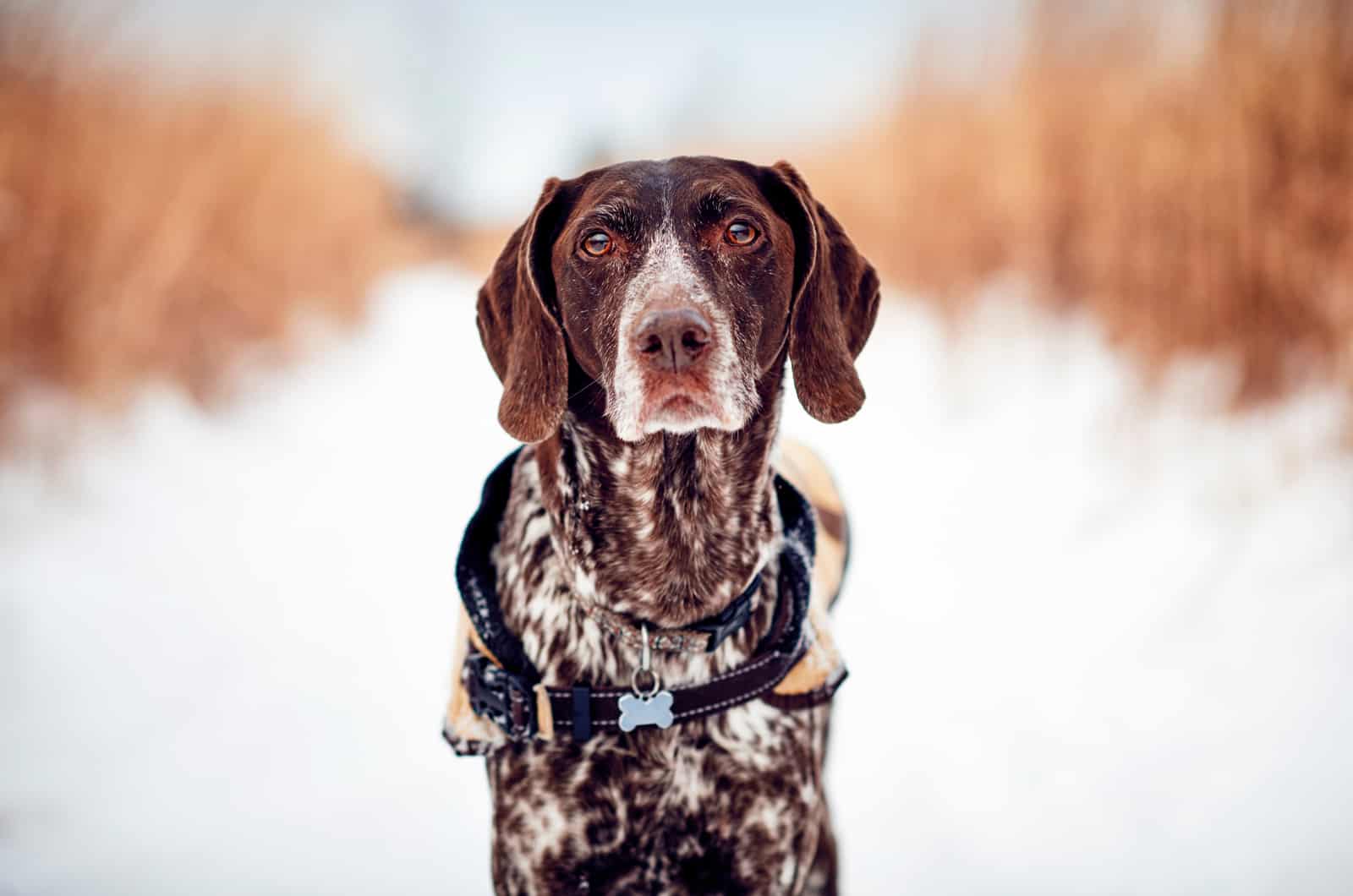
Now that you know all about the German Shorthaired Pointer colors and coat grooming, there’s one thing left to think about: Does color even matter?
Coat color doesn’t impact a dog’s behavior in any way. All GSPs are active canines that make great watchdogs and family companions, although they do require training sessions to keep their independent temperament at bay. Otherwise, expect constant growling and running after every smell and sound!
If you want to become a GSP owner, remember to buy one from a reputable breeder. Contact the German Shorthaired Pointer Club of America if you aren’t certain where to look.
When you buy from a responsible breeder, you’ll get a healthy dog that won’t shed as much as dogs with health problems. Not to mention many other pros that come with buying from the right seller.
Remember to brush your GSP regularly and not go overboard with bathing. No matter the German Shorthaired Pointer color, these pups can shed, and you should do all you can to reduce the amount of shedding.
And remember: All dogs are good dogs. Coat color is just an appearance, and it shouldn’t be the determining factor when you want to purchase a dog for yourself.
